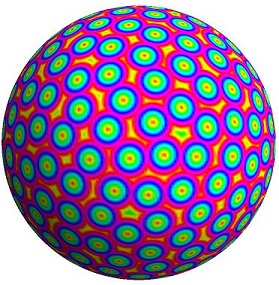Quasi-Monte Carlo Methods: Theory and Applications
FWF Special Research Program (SFB)
Project Part 03 (P. Grabner): Distributing Points on Spheres and Manifolds: Minimal Energy and Designs
SFB funding period 2 (2018-2022)
Quasi-Monte Carlo-methods for the construction of well-distributed point sets on spheres of arbitrary dimension are much less developed than in the classical Euclidean case. Especially, methods which respect the spherical geometry and do come from transporting Euclidean point sets to the sphere via parametrisations are very rare. Several constructions of point sets are known, such as minimal energy point configurations, spherical designs, spiral points, and equal area partitions. On the other hand, several quality measures for spherical point sets are known, which are used to assess the finer distribution properties of point sets: integration error for Sobolev spaces, discrepancy, energy, separation, and packing. As an outcome of a special semester at the Erwin Schrödinger Institute run during the first period of the programme the notion of hyperuniformity could be added to this list. The notion was originally developed to assess infinite Euclidean point sets, but can be adapted to measure the quality of finite spherical point sets. The second period of the programme shall be used to compare different quality measures for point distributions on spheres, to develop new constructions of well-distributed point sets and to assess their quality, and to fully understand and develop the notion of hyperuniformity in the context of point sets on the sphere (and other compact spaces).

SFB funding period 1 (2014-2017)
This project part is concerned with constructions of well-distributed point sets on compact manifolds, especially the $d$-sphere $\mathbb{S}^d\subset\mathbb{R}^{d+1}$.
Minimal energy point sets
For a given compact manifold $M\subset\mathbb{R}^{d+1}$ and a set of $N$ distinct points $X_N=\{x_1,\ldots,x_N\}\subset M$, the Riesz $s$-energy is defined as $E_s(X_N)=\sum_{i\neq j}\|x_i-x_j\|^{-s}$.
A configuration $X_N^*$, which minimizes $E_s$ amongst all $N$-point configurations, is called a minimal energy configuration. The motivation for studying such configurations comes from Chemistry and Physics, where self-organization of mutually repelling particles under inverse power laws occur. For fixed $s$ and $N\to\infty$ the distribution $\frac1N\sum_{j=1}^N\delta_{x_j^*}$ approaches a continuous limiting measure, which can be described by classical potential theory, if $s< \dim(M)$, and which is normalized Hausdorff measure, if $s\geq\dim(M)$ by a recent result of D.P. Hardin and E.B. Saff.
Spherical designs
A spherical $t$-design is a finite set of points $X\subset\mathbb{S}^d$ such that $\frac1{\# X}\sum_{x\in X}p(x)=\int_{S^d} f(x)\,d\sigma(x)$ for all polynomials $p$ of degree $\leq t$, where $\sigma$ denotes the normalized surface measure on $S^d$. Only recently A.V. Bondarenko et al. could show that $t$-designs with $O(t^d)$ exist. This is the same order of magnitude as previously known lower bounds. The discrepancy, integration error, and separation properties of minimal energy point sets and designs shall be analyzed. Furthermore, number-theoretic constructions for well-distributed point sets on the sphere shall be investigated further.







